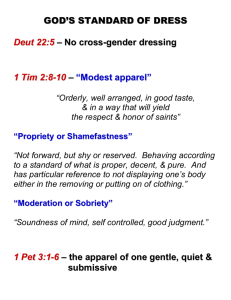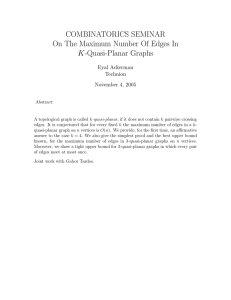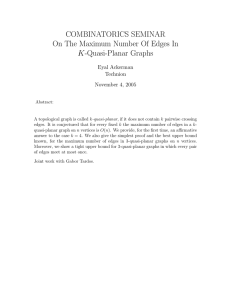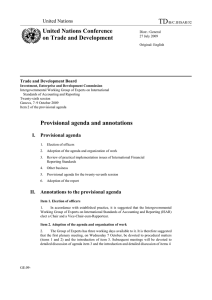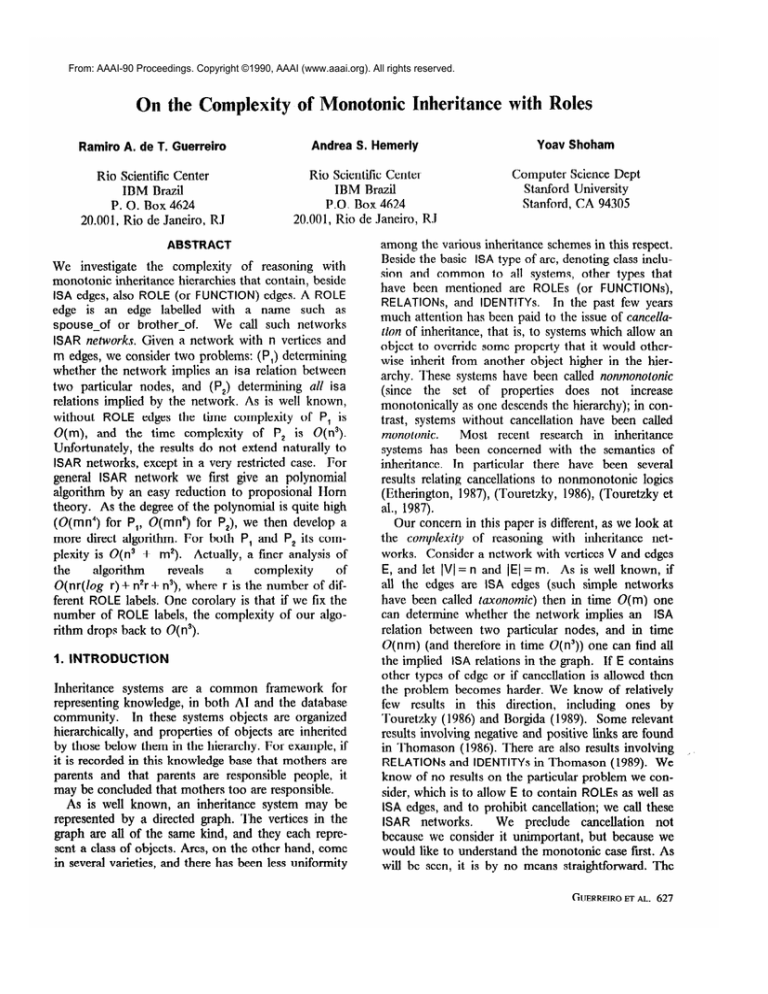
From: AAAI-90 Proceedings. Copyright ©1990, AAAI (www.aaai.org). All rights reserved.
On the Complexity of Monotonic Inheritance with Roles
Ramiro A. de T. Guerreiro
Andrea S. Hemerly
Yoav Shoham
Rio Scientific Center
IBM Brazil
P. 0. Box 4624
20.001, Rio de Janeiro, RJ
Rio Scientific Center
IBM Brazil
P.O. Box 4624
20.00 1, Rio de -Janeiro, R.J
Computer
Science Dept
Stanford University
Stanford, CA 94305
ABSTRACT
We investigate
the complexity
of reasoning
with
monotonic
inheritance
hierarchies that contain, beside
ISA edges, also ROLE (or FUNCTION) edges. A ROLE
edge is an edge labelled
with a name
such as
We call such networks
spouse-of or brother-of.
ISAR networks. Given a network with n vertices and
m edges, we consider two problems:
(P,) determining
whether the network implies an isa relation between
two particular
nodes, and (P,) determining
all isa
relations implied by the network.
As is well known,
without
ROLE edges the time complexity
of P, is
O(m), and the time complexity
of P, is O(n3).
Unfortunately,
the results do not extend naturally
to
ISAR networks,
except in a very restricted case. For
general ISAR network
we frost give an polynomial
algorithm
by an easy reduction
to proposional
Horn
theory.
As the degree of the polynomial
is quite high
(O(mn4) for P,, O(mn’) for P,), we then develop a
more direct algorithm.
For both P, and P, its complexity is O(n3 + m*). Actually, a finer analysis of
complexity
of
the
algorithm
reveals
a
O(nr(Zog r) + n*r + n3), where r is the number of different ROLE labels. One corolary is that if we fix the
of our algonumber
of ROLE labels, the complexity
rithm drops back to O(n3).
1. INTRODUCTION
Inheritance
systems
are a common
framework
for
representing
knowledge,
in both AI and the database
community.
In these systems objects are organized
hierarchically,
and properties
of objects are inherited
by those below them in the hierarchy. For example, if
it is recorded in this knowledge base that mothers are
parents
and that parents
are responsible
people, it
may be concluded that mothers too are responsible.
As is well known,
an inheritance
system may be
represented
by a directed graph. The vertices in the
graph are alI of the same kind, and they each represent a class of objects. Arcs, on the other hand, come
in several varieties, and there has been less uniformity
among the various inheritance
schemes in this respect.
Beside the basic ISA type of arc, denoting class inclusion and common
to all systems, other types that
have been mentioned
are ROLES (or FUNCTIONS),
RELATIONS, and IDENTITYs.
In the past few years
much attention
has been paid to the issue of cancellation of inheritance,
that is, to systems which allow an
object to override some property that it would otherwise inherit from another object higher in the hierarchy. These systems have been called nonmonotonic
(since
the
set of properties
does
not
increase
monotonically
as one descends the hierarchy); in contrast, systems without cancellation
have been called
monotonic.
Most recent
research
in inheritance
systems has been concerned
with the semantics
of
inheritance.
In particular
there have been several
results relating cancellations
to nonmonotonic
logics
(Etherington,
1987) (Touretzky,
1986), (Touretzky
et
al., 1987).
Our concern in this paper is different, as we look at
the complexity of reasoning
with inheritance
networks.
Consider a network with vertices V and edges
E, and let IV1 = n and IEI = m. As is well known, if
all the edges are ISA edges (such simple networks
have been called taxonomic) then in time O(m) one
can determine
whether the network implies an ISA
relation between
two particular
nodes, and in time
0( nm) (and therefore in time 0( n3)) one can find all
the implied
ISA relations in the graph.
If E contains
other types of edge or if cancellation
is allowed then
the problem
becomes harder. We know of relatively
few results
in this direction,
including
ones by
Touretzky
( 1986) and Borgida (1989). Some relevant
results involving negative and positive links are found
in Thomason
(1986). There are also results involving
RELATIONS and IDENTlTYs in Thomaaon
(1989). We
know of no results on the particular problem we consider, which is to allow E to contain ROLES as well as
ISA edges, and to prohibit cancellation;
we call these
ISAR networks.
We preclude
cancellation
not
because we consider it unimportant,
but because we
would like to understand
the monotonic
case frost. As
will be seen, it is by no means straightforward.
The
GUERREIRO
ETAL. 627
,
problem lies in a new closure rule that is provided by
the interaction
between ROLES and ISA edges. Consider for example the following graph:
SYNTAX
NETWORKS
AND
SE
In order to be able to define our problem
we first
present the syntax and semantics for monotonic
ISAR
networks.
Their syntax is defmed as follows.
Intuitively,
since mothers
are parents,
spouses
of
mothers are also spouses of parents.
In other words,
an ISA relation is implied about the two right nodes.
Of course, this intuitive claim needs to be formalized, and we will indeed do that. We will then consider the complexity
of determining
the implied
ISA
relations in such a network.
In a very restricted type
of ISAR networks we will be able to salvage the O(m)
and 0( nm) results from the simple taxonomic
case.
we will offer a slightly
For general ISAR networks
costlier O(n3 + m*) algorithm to find all the implied
ISA relations. Actually, a finer analysis of our general
algorithm reveals a complexity
of O( nr( log r) + n*r
+ n3 ), where r is the number of ROLE labels in the
network
(we distinguish
ROLE labels which are distinct,
like brother-of
and spouse-of,
and actual
ROLE edges, in which ROLE labels may be repeated).
Note that we have r I m, but we do not have m I n*,
since, unlike
ISA edges, we may have multiple ROLE
edges between two nodes (the spouses of mothers are
exactly the joint-tax-payers
of mothers). Among other
things, this finer analysis takes us back to O(n3) for
by a constant.
As this is close to the
an r bounded
best known algorithm for simple taxonomic
networks
it seems unlikely that this result can be significantly
improved.
The remainder
of the article is organized as follows.
In section 2, we briefly define the semantics
of ISAs
and ROLES, and based on these we provide provably
complete
conditions
for determining
all the implicit
ISAs entailed by a given ISAR network.
In section 3,
we formally defme the graph theoretic
problem.
In
section 4, we briefly recall the results on taxonomic
hierarchies,
all well known.
In section 5, we finally
turn to the complexity
of reasoning
with ISAR networks.
In section 5.1, we extend
the results of
section 4 to a restricted kind of ISAR networks which
we call “equi-multiple
inheritance”-EAR
(EMI-ISAR)
networks.
We then turn to the general case. First, in
section 5.2, we provide a polynomial
algorithm which
reduces the problem to that of determining
entailment
by a propositional
Horn theory. The degree of the
polynomial
turns out to be quite high, and so, in
section 5.3, we give another,
more direct algorithm,
whose complexity
was discussed
above. Finally,
in
section 6 we summarize
our results, compare them to
previous results of which we are aware, and point to
some open questions.
628 KNOWLEDGEREPRESENTATION
Definition
ISAR
1: Let V and L be two disjoint sets. An
network is a triple
< V,E,,E, > where
E,cV X V, E,cV
X V X L and it satisfies:
1) If (a,b,p)eE, and (a,c,p)eE,
2) If peL then there are ad
that (a,b,p)eE,.
then b = C;
and beV such
V is the set of vertices, L is the set of ROLE
labels, E, is the set of ISA edges and E, is the set
of ROLE edges.
The second condition
in the above deftition
is not
essential,
but it guarantees
that any ROLE label
indeed labels at least one ROLE edge, which is convenient.
We now defme their semantics.
Definition 2:
Jet
N= <V,E,,E,>
be
an
ISAR
network
and L the set of ROLE labels of N A
model for N is a pair < D,ll/ > where D is a set
and $ is a (total) function on VUL such that:
1) If ad then Il/(a)ED;
2) If peL then $(p) is a partial
DtoD;
3) if (a,b)EE, then ti(a)c$(b);
4) if W,pW,
Next we define
one syntatic.
function
from
then $(W = vW04a)).
two isa relations,
one
semantic
and
Definition 3:
Let N= <V,E,,E,>
be
an
ISAR
network.
The binary
relation
isa, on V is
defined
by:
isa,(a,b)
iff for every
model
< D,$ > for N, it is the case that +(a)z$(b).
We will denote the fact that isa,(a,b) holds by
N j= isa(a,b).
Definition 4:
J,et
N = < V,E,,E, >
be
an
ISAR
network.
The binary relation
isa, on V is the
smallest set satisfying:
1) If (a,b)EE, or a = b then (a,b)eisa,;
2) (Rulel)
If (a,b)eisa,
and (b,c)dsa,
(a,c)eisa,;
3) (Rule2)
If (a,b)Eisa,,
(a,c,p)eE,
(b,d,p)eE, then (c,d)Eisa,.
We will denote
then
and
the fact that isa,(a,b) holds by
Ntisa(a,b).
There
The next theorem
establishes
actually the same relation.
that
isa, and
isa, are
Theorem 1: (Soundness
and
Completeness)
Let
N = < V,E,,E, > be an BAR network.
For every
ad and beV, N/-isa(a,b) iff N+=isa(a,b).
Proof (-+)Note that if (a,b)eE, then Nj=isa(a,b); and
also that Rule1 and Rule2 are sound with respect to
our semantics.
(+--)We omit this part of the proof; it
will be included in the long version of this paper.
Note that if E, is empty then the ISAR network
reduces to a simple taxonomic
inheritance
network.
3. FORMAL
PROBLEM
DEFlNlTlON
Given the syntax and semantics
now formally
define the two
addressing.
P,.
an BAR network N = < V,E,,E, >
and a pair of vertices xy in V
‘yes’ if N + isa(
‘no’ otherwise
Input:
Output:
P**
of ISAR networks, we
problems
we will be
an ISAR network N = < V,E,,E,>
an ISAR network N = < V,E,‘,E, >
such that E,’ = ((xJ): N + isa(
Input:
Output:
If IV1 = n and
COMP,
is the time
HIERARCHIES:
A
In fact, there exists a theoretically
even better algorithm
for P,, whose complexity
is about
O(n*-‘).
EIowevcr, this theoretical
result has not been translated to a practical advantage.
We mention
these results for two reasons. First, as
these are the best known results for taxonomic
networks (and of course the linear result for P, is
provably optimal) they form a lower bound for what
we might expect for ISAR networks, and are good reference
points
against
which
to test our results.
Second, the details of the algorithms mentioned
above
provide good insight into the qualitative
increase in
difficulty of ISAR networks.
In the next section we
discuss
the DFS algorithm,
and why it can be
extended
only to a limited class of ISAR networks.
The dynamic
programming
algorithm,
on the other
hand, does not extend at all as far as we can see.
Briefly, it relies on the property
that if a path is
decomposed
at any vertex then each component
is
itself a path; that is true for simple taxonomic
hierarchies, but not for general ISAR networks.
FOR ISAR NETWORKS
We now
address
the two problems
defined
in
section 3, P, and P,, in the context of general ISAR
networks.
We start with a very efficient algorithm for
a restricted class of ISAR networks. We then give an
easy algorithm for the general case whose complexity,
though
polynomial,
is uncomfortably
high. Finally,
we give a low polynomial
algorithm
for the general
case.
5.1 EMI-ISAR
In this section
we briefly review the well-known
results for the case in which the network
contains
only ISA edges.
Theorem 2: There exists an O(m) algorithm for P,.
Proof. Use, e.g., the depth-frost search (DFS) algorithm for directed graphs (Aho et al., 1974).
In fact, DFS may be used to find in O(m) time all the
nodes reachable from a given node. We therefore have
the following:
Corollary 1: There exists an O( nm) algorithm
Proof. Run a DFS from each node.
for P,:
Theorem 3: There exists an O(n3) algorithm for P,.
Proof. Use the dynamic progamming
algorithm
of,
e.g., (Aho et al., 1974).
5. ALGORITHMS
Note that r 5 m and m 5 rn*.
TAXONOMIC
direct algorithm
of Pi
complexity
(i = 1,2), then clearly we have COM P, I
n*COMP,,
since we solve P, by solving P, for each pair of nodes.
In the rest of this paper, the number
of vertices,
IVl, will be n, the number of edges, IE,I + IE, I, will
be m and the number of ROLE labels, IR I, will be r.
4. SIMPLE
REVIEW
is also the well known
for P,.
networks
The DFS algorithm for taxonomic
hierarchies extends
paths into the graph, backtracks chronologically
when
a path is blocked, and never traverses the same edge
twice. In this section we extend the algorithm
to
ISAR networks, introducing
two major modifications.
First, paths are extended in a way that is more complicated than simply following ISA edges. Second, in
order to guarantee that we do not lose completeness
by not traversing edges more than once (which guarantees linearity)
we will need to impose
a strong
restriction
on the network.
Given the space limitations on this paper, we will only illustrate the algorithm
through
an example.
Consider
the simple
network in Figure la.
GUERREIROETAL.
629
Definition 6: An
ISAR network
is an equi-multiple
inheritance-ISAR network (EMI-ISAR network) if
for any two nodes x and y, all paths from x to y
have the same label.
Theorem 4: In the case of EMI-ISAR
a
X2
C
d-i-
b
x2
1x1
f
F%-i;-Ti
Jrl
2
!%I
X2
Z:integers,
Z +:nonnegative
Z,
R:reals,
R+:nonnegative
R,
Qrationals,
x2: squaring
1x1: the absolute value function,
X2
function
networks there
exists an O(m) algorithm for P,.
Proof. Develop paths of the sort described above in a
depth-first
fashion,
backtracking
chronologically,
never traversing an edge twice.
In fact, just as in the simple taxonomic
case, this
extended
DFS can be used to discover all nodes to
which a path exists from a given node. We thus get
the following:
Figure 1
Now consider the query ‘isa({289},R’-)‘.
This query
should succeed due to the path shown in Figure lb,
which consists of three types of edge traversal:
going
back on ROLE edges (e.g., Z+ to Z), going up ISA
edges (e.g., Z to Q), and going forward on ROLE
edges (e.g., R to R +). We will call these respectively
left, up and right traversal. Left and up traversals have
no preconditions.
Right traversal has a precondition
that it not immediately
follow a left traversal, and that
the last left traversal to precede it was along a ROLE
with the same label. To implement
this we maintain
a
stack as we develop a path: up traversal does not
affect the stack, back traversal pushes the ROLE label
onto the stack, right traversal pops the stack (and has
1c- 1j
Figures
the precondition
mentioned
above).
illustrate the stack at all the vertices along the path in
Figure lb.
Lemma 1: Let N be an ISAR network.
Then
N #= isa
iff there is a path of the sort
described above that starts at x with an empty
stack and ends at y with an empty stack.
The only question that remains is how to determine
efficiently whether such a path exists. Unfortunately,
in ISAR networks with multiple inheritance
we will in
general need to traverse some edges many times. A
simple example exists already in Figure la: if the first
path developed
is {289}{ 1732 + QR, then at that
point backtracking
must occur. If we are not allowed
to traverse the edge QR twice, then we will not discover the path {289}{17}Z+ZQRR+R+,
and thus
miss a solution.
In special case, however, it is safe to
not traverse an edge twice:
Definition 5
The
ROLE labels
edges.
label of a path is the sequence
of
appearing
in it, ignoring
all ISA
630 KNOWLEDGEREPRESENTATION
Corollary 2: In the case of EMI-ISAR
exists an O( nm) algorithm
Note that our results
contains cycles.
5.2 Reducing
propositional
hold
networks
there
for P,.
also
when
general ISAR networks
Horn theory
the
network
to
We now start to look at the general case of ISAR networks.
In this section we pursue an easy way out,
namely to reduce the graph theoretic problem to the
problem
of deciding a query about a propositional
Mom theory, which is known to be decidable in linear
time (Dowling and Gallier, 1984). Unfortunately,
the
resulting datalog theory will not be linear in the size
of the ISAR network.
Let N = < V,E,,E,>
be an ISAR network.
We
construct
a Horn theory Th(N) as follows. First, for
each three vertices XJ,Z in N, we construct a clause
isa(x\y)
< - isa(x,z)
A isa(z&
Then, for each four vertices V,XJ,Z in N and
ROLE label 2 we construct a clause
isa(x&
each
< - isa(v,z) A role(Z,v,x) A role(Z,z&
Finally, for every pair (a,b) in E, we add a predicate
isa(a,b), and for every triple (a,b,p) in E, we add a
predicate role(p,a,b).
Theorem 5: There
exists
an
O( rn4) (and
thus
O( m n4)) algorithm for P,.
Proof. From Theorem
1 we have that N k isa
iff Th(N) + isa(x&.
The latter can be decided in
time linear in Th(N). The number of clauses in Th(N)
is O(n3+rn4) = O(rn4).
Corollary 3:
There
exists
an
O( m n6)) algorithm for P,.
O(rn8)
(and
thus
5.3 An efficient
networks
algorithm
for general
EAR
The degree of the polynomial
in the previous
algorithm is a bit too high for comfort. We now offer a
more direct algorithm
whose complexity
is much
lower.
Definition 7: A directed
AND/OR graph is one in
which the set of edges emanating
from each node
is partitioned
into
sets, each set called
an
AND-set of that node (single edges are viewed as
singleton sets). A path in such a graph is a rooted
tree such that the set of edges in the tree emanating from each vertex forms an AND-set of that
Searching
an
vertex in the AND/OR graph.
AND/OR
graph
from
a given vertex
means
starting with a path consisting
of the node itself,
and iteratively extending it.
Lemma 3: It can be determined
in time O(m’) simultaneously
for all vertices in EVID(N) whether
there is a grounded
path rooted at them, where
m’ is the number of edges in EVID( N).
Proof. (outline)
Conduct
a breadth-first
search
(BFS) starting from all nodes (i,j) such that (i,j) is in
E,, moving
backwards on edges, and extend a path
beyond
a vertex only when at least one of its
AND-sets has all its members
originate in previouslyreached nodes.
The last lemma points to the reason for constructing
the evidence graph. We now note that m’ is bounded
EVID(N).
To comby the complexity
of generating
plete the story, then, it remains to estimate this complexity. We fast show an easy bound, and then look
more closely at the algorithm
to improve
the complexity.
Theorem
Definition 8: Let N= <V,E,,E,>
be an
ISAR
network.
The evidence graph of N is the
AND/OR
directed
graph
EVID(N) = < V*,E’>
where
E’= {((k,l),(i,j)):
for some p, (i,k,p) and
(j,l,p) are both in EJ
U { (((i,k),(i,j)),((i,k),(j,k))):
i,j,k in V>.
The fast type of edge is shown pictorially below:
iQ
k
P,
c9 Ci,j)
Ck,h> &
i*
P
N
_ 2
cj,i)
(h,kl EVID( N)
The intuition
behind
the construction
is the following: an AND-set of a vertex (i,j) in the evidence
graph is evidence that (i,j) is in the isa relation. More
precisely, we have the following:
Definition 9: Let N= <V,E,,E, >
be
an
ISAR
network.
A path rooted at (a,b) in EVID( N) is
said to be grounded if a = b or for all terminal
nodes (k,l) in that path it is the case that (k,l) is
in E,.
Lemma 2: Let N = < V,E,,E, > be an ISAR network
and i,j in V.
Then
N/=isa(i,j) iff there is a
grounded path in EVID(N) rooted at (i,j).
Proof. (outline)
By theorem
1, N+isa(i,j)
if and
only if N/-isa(i,j).
By induction
on the number
of
applications
of Rule 1 and Rule2 (Definition
4) we
have that if Ntisa(i,j).
then there is a grounded path
rooted at (i,j) in EVID(N). By induction
on the the
size of the path we may prove that if there is a
grounded
path
rooted
at (i ,j) in EVID(N) then
Ntisa( i,j).
6: There
exists an U(n3 + m*) algorithm for
p2.
Proof. The construction
of the edges in EVID(N) that
are due to the transitive closure is done in time 0(n3).
To construct
the other edges, we look at all pairs of
ROLE edges (i,j) and (k,l), and, if their ROLE labels
and
agree, add to EVID(N) the edges ((i,k),(j,l))
((j,l),(i,k)). The total number of edge-pairs is O(m*).
Thus
the total
complexity
of the algorithm
is
O(n3+ m*).
Recall that in ISAR networks
there is no necessary
relation
between
the number
of vertices and the
number
of edges.
However,
if it happens
that
m = O(n*), we have that the algorithm
is of complexity O(n4). We now improve on this by a more
careful construction
of the evidence graph.
Theorem 7: There
exists an O( nr(logr) + n*r + n3)
algorithm
for P,, where r is the number
of diiferent ROLE labels.
Proof. We create the first n3 edges as before. Then,
rather than blindly compare all pairs of edges, we do
the following.
1) Create a list for each vertex of all the ROLE edges
emanating
from it and their associated
label. A
typical list will have the form i: (I,,i,),(l,,i,),
... .
(where i, i, and
i, are vertices, and I, and I, are
ROLE labels);
2) Sort each of these lists by the label component;
3) For each pair of vertices i,j, scan their lists in parallel to see which role labels they share. If you
encounter
the pair (p,k) in i’s list and the pair
(p,l) in j’s list, add the edges ((k,l),(i,j))
and
((LWj,O).
GUERREIROETAL.
631
Complexity
of the steps:
1) WW;
2) Q( nr(Zogr)) (note that each list is of length r at
most);
3) O(n*r) (scanning
the sorted lists is linear in their
length, r, and there are n* pairs of vertices).
We also note that we have m 5 n*r, and so the total
complexity
the
evidence
graph
is
of creating
O(nr(Zogr) + n*r + n3).
Corollary 4: If the number
by a constant,
of ROLE labels is bounded
there is an 0(n3) algorithm for P,.
We note that as this is realistically
the lowest complexity known
for transitive
closure, we hould not
hope to improve on this.
6. SUMMARY
AND
DISCUSSION
We haI-, offered new results on the complexity
of reasoning with inheritance
hierarchies
with ROLES, or
ISAR networks.
We defmed two problems,
P, (determining
whether
a ISAR network
implies
an isa
relation on two nodes) and P, (fmding the closure of
the isa relation).
Let n be the number of vertices of
m the number of edges, and r the
an ISAR network,
number
of distinct
ROLE labels.
To somewhat
crudely summarize
our results, we have the following.
although
at first glance it seems that P, is much
easier.
Actually,
our experience
with the problem
leads us to conjecture
that P, is not any easier, but it
would be nice to have a result on that. Then there is
a question
about
other
ways
to
salvage
the
O(n),O( n m) results from the simple taxonomic
case:
do there exist interesting
classes of networks
which
permit that other than EMI-ISAR networks?
Finally,
what happens
when we add other features to the
network,
such as RELATIONS or cancellation?
We
conjecture
that at least in the latter case the problem
in general becomes intractable,
which seems to agree
with Borgida’s result mentioned
above.
Acknowledgments.
The
authors
are grateful
to
Richmond
I-I. Thomason,
who
described
the
problem, and for helpful suggestions on a first version
of this paper.
REFERENCES
Aho, A. V., Hopcroft,
J. E., and Ullman, J. D. eds.
1974. The Design and Analysis of Computer Algorithms, Addision Wesley.
Rorgida, A. 1989. Type Systems for Querying
Class
IIierarchies
with
Non-Strict
Inheritance.
In Proceedings of PODS-89.
Dowling, W. and Gallier, J. 1984. Linear-Time
Algorithms for Testing the Satisfiability
of Propositional
Horn
Formulae.
Journal of Logic Programming,
1( 3):267-284.
Ether&ton,
D. W. 1987. More on Inheritance
Hierarchies with Exceptions.
In Proceedings
of American
Assiciation
for Artificial Intelligence,
352-357.
The only results bearing directly on ISAR networks
with which we are familiar are due to Borgida ( 1989).
His results include
NP-Hardness
for networks
with
cancellation,
and polynomial
results for two other
problems.
We do not yet understand
well the relation
between his results and ours. There appear to be few
other complexity
results. We are aware of Touretzky’s
(1986) polynomial
algorithm
for parallel
networks
with RELATIONS, but do not see an interaction
with
our work.
Our results leave open some interesting
questions.
Our general result for P, is somewhat worse than the
O(nm) of transitive
closure;
can it be improved?
Another
striking feature of our result is that in the
general case we have identical results for P, and P,,
632
KNOWLEDGEREPRESENTATION
Thomason,
R. II., Horty, J. F., and Touretzky,
D. S.
1986.
A Calculus
for Inheritance
in Monotonic
Semantic
Nets Relations
and Identity.,
Technical
Science
Report
CMU-CS-86
1.138,
Computer
Department,
Carnegie-Mellon
University.
Thomason,
R. II. 1989. Completeness
Proofs for
Monotonic
Nets with Relations and Identity. In Proceedings of the Fourth
International
Symposium
on
Methodologies
for Intelligent Systems, 523-532.
Touretzky,
D.
S.
1986.
Jnheritance Systems. Morgan
The
Mathematics
Kaufmann.
of
Touretzky,
D.S., Horty, J. F., and Thomason,
R. I-1.
1987.
A Clash
of Intuitions:
current
state of
nonmonotonic
multiple inheritance.
In Proceedings
of
the Tenth International
Joint Conference
on Artificial
Intelligence,
476-482.

